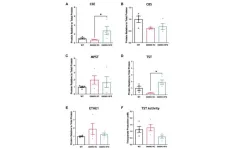(Press-News.org) URBANA, Ill. — Food waste is a major problem around the world. In the United States, an estimated 30 to 40% of edible food is lost or wasted, costing billions of dollars each year. One potential solution is to divert food waste from landfills to renewable energy production, but this isn’t done on a large scale anywhere. A new study from the University of Illinois Urbana-Champaign investigates the feasibility of implementing energy production from food waste in the state of Illinois.
“We have a large amount of organic waste in the U.S., which eventually enters landfills and emits greenhouse gasses. However, this material can be converted into a renewable energy resource using anaerobic digestion. This solution simultaneously deals with excess food and contributes to sustainable energy production,” said Jason Uen, a doctoral student in the Department of Agricultural and Biological Engineering (ABE), part of the College of Agricultural, Consumer and Environmental Sciences and The Grainger College of Engineering at Illinois. Uen is lead author on the paper, published in the Journal of Cleaner Production.
The researchers conducted a comprehensive analysis of supply chain logistics to determine if a system of converting food waste into energy and other bioproducts would be profitable in Illinois. First, they used geospatial data to identify potential sites. Next, they analyzed technological and economic factors, including transportation, production, and facility costs, as well as revenue and return on investments.
“Anaerobic digestion is not a new technology, but if it were profitable, I would expect it to be more widely implemented. That’s why it was quite surprising that our study showed promising results despite the very conservative assumptions we put into the analysis. There are some sectors that really ought to consider this as a potentially viable technology with an attractive return on investment,” said Luis F. Rodriguez, associate professor in ABE and co-author on the paper.
Anaerobic digestion is a biological process that decomposes organic feedstock using rich organic materials such as wastewater sludge, animal manure, or yard waste. This can be accomplished at stand-alone facilities or at wastewater treatment plants for a co-digestion process. The resulting biogas can be used to produce electricity, which can be transported to consumers via regional power grids. The process also yields additional bioproducts, including biofertilizer and animal bedding materials that can be sold to agricultural producers.
“This is an opportunity for wastewater treatment plants, but we've also shown that there's potential for new stand-alone facilities to provide a service that can generate revenue while dealing with an environmental concern that is currently unaddressed. A new industry could form around this,” Rodriguez said.
The study showed that installing anaerobic co-digesters at wastewater treatment plants with a total annual capacity of 9.3 million metric tons could generate an 8.3% return on investment while reducing carbon dioxide by approximately one million metric tons annually. The most significant factors influencing the results were capital investment, operational cost, and tipping price, which is a service charge for waste disposal.
Food waste availability is also an important factor, including the challenge of sorting and transporting food waste from households. In the study, Uen and Rodriguez assume food waste amount is directly related to population density distribution. This means facilities would be collecting waste within a ten-mile radius from residential areas. To estimate revenues, the researchers included wholesale electricity price and current fertilizer prices.
“There is still a big gap between the market demands for bioproducts and the amount of food waste we have,” Uen said. “If we can expand the marketability of those products, then the profitability for converting food waste into sustainable resources will further increase.”
Government policies such as higher incentives for carbon reduction efforts could also make it more attractive to implement these technologies, he added.
The study focused on Illinois, and the next step would be expanding to a nationwide analysis. Estimating food waste availability on a larger scale and determining bioprocessing techniques will be essential for improving food waste utilization and the circular bioeconomy in agriculture, Uen and Rodriguez concluded.
Editor’s Notes:
The paper, “An integrated approach for sustainable food waste management towards renewable resource production and GHG reduction,” is published in the Journal of Cleaner Production [doi.org/10.1016/j.jclepro.2023.137251].
Funding was provided by the National Science Foundation (grant numbers 1833225, 1639340), the USDA National Institute of Food and Agriculture (grant number ILLU-741-624), and the Taiwan-UIUC Fellowship.
The College of Agricultural, Consumer and Environmental Sciences (ACES) at the University of Illinois has top-ranked programs, dedicated students, and world-renowned faculty and alumni who are developing solutions to the world’s most critical challenges to provide abundant food and energy, a healthy environment, and successful families and communities.
END
University of Illinois study finds turning food waste into bioenergy can become a profitable industry
2023-07-11
ELSE PRESS RELEASES FROM THIS DATE:
Hepatic hydrogen sulfide levels are reduced in mouse model of progeria
2023-07-11
“To date, no studies have directly measured [hydrogen sulfide] production in Hutchinson-Gilford Progeria Syndrome [...]”
BUFFALO, NY- July 11, 2023 – A new research paper was published in Aging (listed by MEDLINE/PubMed as "Aging (Albany NY)" and "Aging-US" by Web of Science) Volume 15, Issue 12, entitled, “Hepatic hydrogen sulfide levels are reduced in mouse model of Hutchinson-Gilford progeria syndrome.”
Hutchinson-Gilford progeria syndrome (HGPS) is a rare ...
Missing a rare cause of hereditary cancer
2023-07-11
New research from Cedars-Sinai Cancer investigators could warrant reconsideration of current screening guidelines to include a poorly recognized cause of Lynch syndrome, the most common cause of hereditary colorectal and endometrial cancers. Their study, published today in the JNCCN—Journal of the National Comprehensive Cancer Network, concluded that the guidelines leave a significant number of patients undiagnosed.
“When patients with Lynch syndrome—whose first cancers generally appear at an early age—aren’t diagnosed promptly, they don’t get appropriate follow-up or surveillance,” said Megan Hitchins, ...
U of M Medical School receives DARPA award to develop detection tools for early symptoms of depression, psychosis and suicidality
2023-07-11
MINNEAPOLIS/ST. PAUL (07/11/2023) — Researchers at the University of Minnesota Medical School recently received a four-year award from the Defense Advanced Research Projects Agency’s (DARPA’s) Neural Evidence Aggregation Tool program. The goal of their project— titled Fast, Reliable Electrical Unconscious Detection (FREUD)—is to develop tools to better detect early symptoms of depression, psychosis and suicidality, with the intent that treatment can be started as early in a condition’s trajectory as possible.
“It’s exactly those early moments when getting someone therapy or mental health services could save their life or ...
Research aims to identify better COPD diagnosis in African American patients
2023-07-11
DENVER — Recently published research suggests that despite showing clear symptoms of chronic obstructive pulmonary disease (COPD), many African Americans are not officially diagnosed with the disease due to flaws in diagnosis methods. The Research was led by National Jewish Health and recently published in the Journal of General Internal Medicine from the COPDGene study.
Fixed-ratio spirometry, a standard method of measuring respiratory capacity, has long been used as a method of detecting COPD. ...
With a comfort promise, new clinic aims to eliminate pain in kids
2023-07-11
Each year, too many kids in the East Bay suffer needlessly from pain related to long-term serious illness, including migraines, joint and abdominal pain, sickle cell anemia and more. A new UCSF Health pain clinic in Walnut Creek is opening to provide relief.
The new clinic extends the reach of the Stad Center for Pediatric Pain, Palliative & Integrative Medicine beyond UCSF Benioff Children’s Hospitals in San Francisco and Oakland. The Center is one of the nation’s most innovative and comprehensive integrative ...
Potential targets to delay motor aging revealed by C. elegans genome-wide screen
2023-07-11
Genome-wide screen in the nematode Caenorhabditis elegans reveals potential targets to delay motor aging, including the phosphatidylinositol 3-kinase VPS-34; genetic and pharmacological partial inhibition of VPS-34 improves neurotransmission and muscle integrity through increased PI(3)P-PI-PI(4)P conversion, ameliorating motor aging in both worms and mice.
#####
In your coverage, please use this URL to provide access to the freely available paper in PLOS Biology: http://journals.plos.org/plosbiology/article?id=10.1371/journal.pbio.3002165
Article ...
Scientists build a healthy dietary pattern using ultra-processed foods
2023-07-11
GRAND FORKS, N.D., July 11, 2023 ̶ Scientists at the USDA Agricultural Research Service’s (ARS) Grand Forks Human Nutrition Research Center led a study that demonstrates it is possible to build a healthy diet with 91 percent of the calories coming from ultra-processed foods (as classified using the NOVA scale) while still following the recommendations from the 2020-2025 Dietary Guidelines for Americans (DGA). The study highlights the versatility of using DGA recommendations in constructing healthy menus.
“The study is a proof-of-concept that shows a more balanced view of healthy ...
Low-glucose sensor in the brain promotes blood glucose balance
2023-07-11
The body’s blood glucose level needs to be maintained in a relatively narrow range. It cannot be too high, as it can lead to diabetes, and it cannot be too low because it can cause fainting or even death.
“There are many glucose-sensing neurons in the brain that are thought to actively participate in detecting small changes of glucose levels in the body and then trigger responses accordingly to return the level to a healthy range,” said Dr. Yong Xu, professor of pediatrics – nutrition, ...
New study is first to find exposure to neurotoxic rodenticide bromethalin in birds of prey
2023-07-11
In 2020, Tufts Wildlife Clinic Director Maureen Murray, V03, published a study that showed 100% of red-tailed hawks tested at the clinic were positive for exposure to anticoagulant rodenticides (ARs). Such exposure occurs when these chemicals are used to kill mice or rats, which eat the poison, and the birds eat the poisoned prey. Now, Murray is expanding that research with a new study published recently in the journal Environmental Pollution, which found that another type of rodenticide—a neurotoxicant called bromethalin—also ...
Changing the way we deliver immune-based cancer drugs could reduce costs by 14%
2023-07-11
ANN ARBOR, Michigan — A new analysis finds that up to millions of dollars could be saved annually on cancer immunotherapy treatments across the Veterans Health Administration by reconsidering how those drugs are delivered.
It’s a concept that could be applied to all cancer centers nationwide. Immune checkpoint inhibitors were initially tested and approved at weight-based dosages but then moved to one-size-fits-all flat doses, in part to reduce drug waste. But researchers from the University of Michigan Rogel Cancer Center found that if vials intended for a single ...





